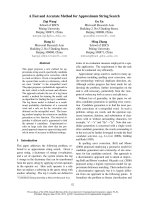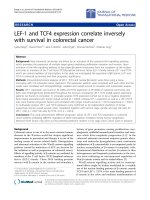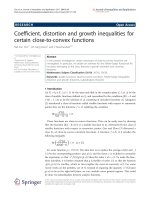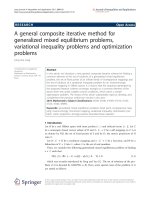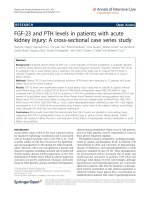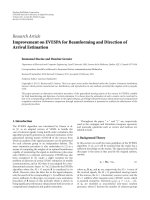Báo cáo hóa học: "RICCATI INEQUALITY AND OSCILLATION CRITERIA FOR PDE WITH p-LAPLACIAN" pptx
Bạn đang xem bản rút gọn của tài liệu. Xem và tải ngay bản đầy đủ của tài liệu tại đây (523.18 KB, 10 trang )
RICCATI INEQUALITY AND OSCILLATION CRITERIA FOR
PDE WITH p-LAPLACIAN
ZHITING XU
Received 1 November 2003; Revised 25 D ecember 2004; Accepted 25 December 2004
Oscillation criteria for PDE with p-Laplacian div(A(x)
Du
p−2
Du)+p(x)|u|
p−2
u = 0
are obtained via Riccati inequality. Some of them are extensions of the results for the
second-order linear ODE to this equation.
Copyright © 2006 Zhiting Xu. This is an open access article distributed under the Cre-
ative Commons Attribution License, which permits unrestricted use, distribution, and
reproduction in any medium, provided the original work is properly cited.
1. Introduction
In this paper, we are interested in obtaining oscillation criteria for the solutions of the
second-order partial differential equation (PDE) with p-Laplacian
div
A(x)Du
p−2
Du
+ p(x)|u|
p−2
u = 0 (1.1)
in the exterior domain Ω(1) :
={x ∈ R
N
: x > 1},wherep>1, x = (x
1
, ,x
N
) ∈ R
N
,
N
≥ 2, Du = (∂u/∂x
1
, ,∂u/∂x
N
), x is usual Euclidean norm in R
N
.
Throughout this paper we will assume that
(A
1
) p ∈ C
μ
loc
(Ω(1)), 0 <μ<1, and p>1 constant,
(A
2
) A = (A
ij
(x))
N×N
is a real symmetric positive define matrix function with A
ij
∈
C
1+μ
loc
(Ω(1)), i, j = 1, ,N,and0<μ<1.
Denote by λ
min
(x) the smallest eigenvalue of A. We suppose that there is a function
λ
∈ C([1,∞),R
+
)suchthat
min
|x|=r
λ
min
(x)
A
q
≥ λ(r)forr>1, (1.2)
where
A denotes the norm of the matrix A, that is, A=[
N
i, j
=1
A
2
ij
(x)]
1/2
,andq is
the conjugate number to p, that is, q
= p/(p − 1).
By a solution of (1.1), we mean a function u(x)
∈ C
2+μ
loc
(Ω(1)) which satisfies (1.1)
almost every on Ω(1). We restrict our attention to the nontrivial solution u(x)of(1.1),
that is, to the solution u(x)suchthatsup
x∈Ω(1)
{|u(x)|} > 0. A nontrivial solution of (1.1)
Hindawi Publishing Corporation
Journal of Inequalities and Applications
Volume 2006, Article ID 63061, Pages 1–10
DOI 10.1155/JIA/2006/63061
2 Riccati inequality and oscillation criteria
is said to be oscillatory if u has zero on Ω(a)foreverya>1. Equation (1.1)issaidtobe
oscillatory if every solution (if any exists) is oscillatory. Conversely, (1.1)isnonoscillatory
if there exists a solution which is not oscillatory.
PDE with p-Laplacian have wide applications in various physical and biological prob-
lems. These equations describe the behavior of the systems w hose energetic functional is
of degree p. Further let u s mention the equation
div
Du
p−2
Du
+ λu = 0, (1.3)
which appears in the study of non-Newtonian fluids. (Non-Newtonian fluids are typically
the fluids which are a suspension of particles, deformed by the acting of forces, in liquid.
Most biological fluids, like blood, have this property.) Other relevant applications of the
equations with p-Laplacian are in the glaciology and slow diffusion problems (the flow
through porous media, e.g., a dam filled by rocks). For more examples of applications the
reader is referred to [1] and the references therein.
In the qualitative theory of nonlinear partial differential equation, one of the impor-
tant problems is to determine whether or not solutions of the equation under considera-
tion are oscillatory. For the quasilinear elliptic equation
div
Du
p−2
Du
+ p(x)|u|
p−2
u = 0. (1.4)
Recently, taking advantage of the oscillation analysis of the second-order linear ordi-
nary differential equation (see, [3, 5, 6])
r(t)y
(t)
+ p(t)y(t) = 0, (1.5)
Usami [4], Xu and Xing [7] have established some oscillation criteria for (1.4). In this
paper, we will continue in this direction and study the oscil latory properties of the gen-
eral equation (1.1). By using the generalized Riccati inequality established in Section 2
(Lemma 2.1), we try to extend the results in [2, 5]to(1.1), which include and improve
the results of Usami [4]. We are especially interested in the case where p(x) has a variable
sign on Ω(1).
2. Preliminaries
In the sequel, we say that a function H
= H(r,s) belongs to a function class Ᏼ, denoted
by H
∈ Ᏼ,ifH ∈ C(D,[0,∞)), where D ={(r,s):−∞ <s≤ r<∞}, which satisfies
H(r,r)
= 0, H(r,s) > 0forr>s, (2.1)
and has partial derivatives ∂H/∂r and ∂H/∂s on D such that
∂H
∂r
= h
1
(r,s)H(r,s),
∂H
∂s
=−h
2
(r,s)H(r,s), (2.2)
where h
1
,h
2
∈ L
loc
(D,R).
Zhiting Xu 3
Let any functions ρ
∈ C([1,∞),R
+
)andκ ∈ C([1,∞),R), we take two integral opera-
tors X
ρ
τ
and Y
ρ
τ
, which are define in [6], in terms of H(r,s)andρ(s)as
X
ρ
τ
(κ;r) =
r
τ
H(s, τ)κ(s)ρ(s)ds, r ≥ τ ≥ 1,
Y
ρ
τ
(κ;r) =
r
τ
H(r,s)κ(s)ρ(s)ds, r ≥ τ ≥ 1.
(2.3)
To formulate our results, we will the following notations. For a given function ϕ
∈
C(R
+
,R
+
), we define
g(r)
=
p
2
λ(r)
ωr
N−1
ϕ(r)
1−q
,
Θ(r)
= ϕ(r)
S
r
p(x)dσ −
1
p
g
1−p
(r)
ϕ
(r)
ϕ(r)
p
,
(2.4)
where S
r
={x ∈ R
N
: x=r}, dσ denotes the spherical integral element in R
N
,andω
represents the surface measure of unit sphere.
In what follows, we will prove three lemmas, which will be useful for establishing os-
cillation criteria for (1.1). The first is modified version of [4, Lemma 1]. The second and
the third are the direct extensions of [2, Lemmas 2.2 and 2.3] to the case of (1.1).
Lemma 2.1. Let u
= u(x) be a nonoscillatory solution of (1.1).Foranarbitrarygivenfunc-
tion ϕ
∈ C
1
(R
+
,R
+
),thenthefunctionZ(r) defined by
Z(r)
= ϕ(r)
S
r
W(x) · ν(x)dσ for r ≥ a ≥ 1 (2.5)
satisfies the generalized Riccati inequality
Z
(r) ≤−Θ(r) −
1
q
g(r)
Z(r)
q
for r ≥ a, (2.6)
where
W(x)
=
Du
p−2
A(x)Du
|u|
p−2
u
, (2.7)
and ν(x)
= x/x, x = 0, denotes the outward unit normal.
Proof. Without loss of generality, we may assume that u
= u(x) > 0forx≥a ≥ 1. In
view of (1.1), a directly computation yields that
divW(x)
=−p(x) − (p − 1)u
−p
Du
p−2
(Du)
T
A(x)Du. (2.8)
Since
W(x)
≤
u
1−p
Du
p−1
A, (2.9)
4 Riccati inequality and oscillation criteria
then
Du
p−2
(Du)
T
A(x)Du
≥ λ
min
(x)Du
p
≥ u
p
λ
min
(x)
W(x)
A
q
≥ u
p
λ
x
W(x)
q
.
(2.10)
Using Green’s formula in (2.5), observing (2.8)and(2.10), we have
Z
(r) =
ϕ
(r)
ϕ(r)
Z(r)+ϕ(r)
S
r
divW(x)dσ
≤
ϕ
(r)
ϕ(r)
Z(r)
− ϕ(r)
S
r
p(x)dσ +(p − 1)λ(r)
S
r
W(x)
q
dσ
.
(2.11)
By H
¨
older’s inequality
S
r
W(x) · ν(x)dσ
≤
S
r
ν(x)
p
dσ
1/p
S
r
W(x)
q
dσ
1/q
=
ωr
N−1
1/p
S
r
W(x)
q
dσ
1/q
,
(2.12)
and by Young’s inequality
ϕ
(r)
ϕ(r)
Z(r)
≤
1
p
g
1−p
(r)
ϕ
(r)
ϕ(r)
p
+
1
q
g(r)
Z(r)
q
. (2.13)
Thus, inequality (2.6)followsfrom(2.11)–(2.13). The proof is complete.
Lemma 2.2. Let u = u(x) be a solution of (1.1) such that u(x)
= 0 for x∈(a,c].For
any ϕ
∈ C
1
([1,∞),R
+
),letZ(r) be defined on (a, c] by (2.5). Then, for any H ∈ Ᏼ and
ρ
∈ C
1
([1,∞),R
+
),wehave
X
ρ
a
Θ −
1
p
g
1−p
h
1
+
ρ
ρ
p
;c
≤−
H(c,a)ρ(c)Z(c). (2.14)
Proof. By Lemma 2.1,wehavethat,fors
∈ (a,c],
Θ(s)
≤−Z
(s) −
1
q
g(s)
Z(s)
q
. (2.15)
Applying the operator X
ρ
r
(a ≤ r ≤ c)to(2.15), using (2.1)and(2.2), we find
X
ρ
r
(Θ;c) ≤−H(c,r)ρ(c)Z(c)+X
ρ
c
h
1
+
ρ
ρ
|
Z|;c
−
X
ρ
r
1
q
g
|Z|
q
;c
. (2.16)
According to Young’s inequality
h
1
+
ρ
ρ
|
Z|≤
1
p
g
1−p
h
1
+
ρ
ρ
p
+
1
q
g
|Z|
q
, (2.17)
Zhiting Xu 5
then, (2.16) can be simplified to
X
ρ
r
Θ −
1
p
g
1−p
h
1
+
ρ
ρ
p
;c
≤−
H(c,r)ρ(c)Z(c). (2.18)
Letting r
→ a
+
in the above, we obtain (2.14). The proof is complete.
Similarly as in the proof Lemma 2.2, we have the following lemma.
Lemma 2.3. Let u
= u(x) be a solution of (1.1) such that u(x) = 0 for x∈[c,b).For
any ϕ
∈ C
1
([1,∞),R
+
),letZ(r) be defined on [c,b) by (2.5). Then, for any H ∈ Ᏼ and
ρ
∈ C
1
([1,∞),R
+
),wehave
Y
ρ
c
Θ −
1
p
g
1−p
h
2
−
ρ
ρ
p
;b
≤
H(b,c)ρ(c)Z(c). (2.19)
3. Main results
The first theorem presents an oscillation criterion for (1.1) which is an analogue of Wint-
ner’s criterion [5]for(1.5).
Theorem 3.1. Assume that there exist functions ϕ,ρ
∈ C
1
([1,∞),R
+
) such that
∞
ρ
(s)
p
ρ(s)g(s)
1−p
ds < ∞, (3.1)
∞
ρ(s)Θ(s)ds =∞, (3.2)
∞
g(s)ρ
1−q
(s)ds =∞, (3.3)
then (1.1)isoscillatory.
Proof. Let u
= u(x) be a nonoscillatory solution of (1.1). Without loss of generality let
us consider that u
= u(x) > 0forx≥l for some sufficient large l>1. Let Z(r)bewell
defined on [l,
∞)by(2.5), from Lemma 2.1,wehavethat
Z
(r)+Θ(r)+
1
q
g(r)
Z(r)
q
≤ 0forr ≥ l. (3.4)
Multiplying (3.4)byρ(s), and integr ating both sides of the results on [l,r], we have
ρ(r)Z(r)+
r
l
ρ(s)Θ(s)ds +
1
q
r
l
ρ(s)g(s)
Z(r)
q
ds ≤ C
1
+
r
l
ρ
(s)Z(s)ds, (3.5)
where C
1
is a constant. H
¨
older’s inequality gives
r
l
ρ
(s)Z(s)
ds ≤
r
l
ρ
(s)
p
ρ(s)g(s)
1−p
ds
1/p
r
l
ρ(s)g(s)
Z(s)
q
ds
1/q
≤ C
2
r
l
ρ(s)g(s)
Z(s)
q
ds
1/q
,
(3.6)
6 Riccati inequality and oscillation criteria
where C
2
=
∞
|ρ
(s)|
p
[ρ(s)g(s)]
1−p
ds is finite by (3.1). Thus, by (3.5)and(3.6), we have
ρ(r)Z(r)+
r
l
ρ(s)Θ(s)ds +
1
q
H(r)
− C
2
H
1/q
(r) ≤ C
1
for r ≥ l, (3.7)
where
H(r)
=
r
l
ρ(s)g(s)
Z(s)
q
ds. (3.8)
Note that for q
≥ 1, the function 1/(2q)H(r) − C
2
H
1/q
(r) is bounded from below on
[0,
∞). By (3.2), (3.7) implies that
ρ(r)Z(r)
≤−
1
2q
H(r)forsomesufficiently large l
1
≥ l. (3.9)
So
Z(r)
≥
1
2q
1
ρ(r)
H(r)forr
≥ l
1
. (3.10)
Thus, we obtain, by (3.10)
H
(r) = ρ(r)g(r)
Z(r)
q
=
1
(2q)
q
g(r)ρ
1−q
(r)H
q
(r)forr ≥ l
1
. (3.11)
Dividing the both sides by H
q
(r) and integrating it, we have
1
q − 1
H
1−q
l
1
≥
1
(2q)
q
r
l
1
g(s)ρ
1−q
(s)ds, (3.12)
which contradicts (3.3). The proof is complete.
Remark 3.2. Let ϕ(r) ≡ 1, Theorem 3.1 improves in [4,Theorem4]for(1.4).
The next theorem is an immediate consequence of Lemmas 2.2 and 2.3, which pro-
vides the domain oscillation criter ia for (1.1) and extends [2, Corollary 2.1].
Theorem 3.3. Assume that for some c
∈ (a,b) and for some H ∈ Ᏼ, ϕ,ρ ∈ C
1
([1,∞),R
+
)
such that
1
H
c,a
X
ρ
a
Θ −
1
p
g
1−p
h
1
+
ρ
ρ
p
;c
+
1
H(b,c)
Y
ρ
c
Θ −
1
p
g
1−p
h
2
−
ρ
ρ
p
;b
> 0,
(3.13)
then every solution u(x) of (1.1) has at least one zero on Ω(a,b)
={x ∈ R
N
: a<x <b}.
Proof. Equation (3.13) implies that both (2.14)and(2.19) do not hold for the given c,and
hence every solution u(x)of(1.1) has at least one zero in Ω(a,b). The proof is complete.
Zhiting Xu 7
Theorem 3.4. Assume that for some H
∈ Ᏼ, ϕ, ρ ∈ C
1
([1,∞),R
+
) such that for each l ≥ 1
limsup
r→∞
X
ρ
l
Θ −
1
p
h
1
+
ρ
ρ
p
g
1−p
;r
> 0, (3.14)
limsup
r→∞
Y
ρ
l
Θ −
1
p
h
2
−
ρ
ρ
p
g
1−p
;r
> 0, (3.15)
then (1.1)isoscillatory.
Proof. For any T
≥ 1, let a = T.In(3.14), we choose l = a. Then there exists c>asuch
that
X
ρ
a
Θ −
1
p
g
1−p
h
1
+
ρ
ρ
p
;c
> 0. (3.16)
In (3.15), we choose l
= c. Then there exists b>csuch that
Y
ρ
c
Θ −
1
p
g
1−p
h
2
−
ρ
ρ
p
;b
> 0. (3.17)
Combining (3.16)and(3.17), we obtain (3.13). The conclusion thus comes from Theo-
rem 3.3. The proof is complete.
Let
H(r,s)
= (r − s)
α
, ρ(s) ≡ 1forr ≥ s ≥ 1, (3.18)
where α>1. Theorem 3.4 reduces to following corollary.
Corollar y 3.5. Assume that there exist a function ϕ
∈ ([1,∞),R) and a constant α>1
such that for each l
≥ 1
limsup
r→∞
r
l
(s − l)
α
Θ(s) −
α
p
p
(s
− l)
α−p
g
1−p
(s)
ds > 0,
limsup
r→∞
r
l
(r − s)
α
Θ(s)ds−
α
p
p
(r
− s)
α−p
g
1−p
(s)
ds > 0,
(3.19)
then (1.1)isoscillatory.
Let
G(r)
=
r
1
g(s)ds for r ≥ 1. (3.20)
Then, we have the following.
8 Riccati inequality and oscillation criteria
Corollar y 3.6. Let G(
∞) =∞ and α>p− 1. Assume that there exists a function ϕ ∈
C
1
([1,∞),R
+
) such that for each l ≥ 1
limsup
r→∞
1
G
α−p+1
(r)
r
l
G(s) − G(l)
α
Θ(s)ds >
α
p
p(α − p +1)
, (3.21)
limsup
r→∞
1
G
α−p+1
(r)
r
l
G(r) − G(s)
α
Θ(s)ds >
α
p
p(α − p +1)
, (3.22)
then (1.1)isoscillatory.
Proof. Let
H(r,s)
=
G(r) − G(s)
α
, ρ(s) ≡ 1forr ≥ s ≥ 1. (3.23)
Then
h
1
(r,s) = h
2
(r,s) = α
G(r) − G(s)
−1
g(s). (3.24)
Noting that
X
ρ
l
g
1−p
h
1
+
ρ
ρ
p
;r
=
α
p
r
l
G(r) − G(l)
α−p
g(s)ds
=
α
p
α − p +1
G(r) − G(l)
α−p+1
,
(3.25)
from (3.21)and(3.25)wehavethat
limsup
r→∞
1
G
α−p+1
X
ρ
l
Θ −
1
p
g
1−p
h
1
+
ρ
ρ
p
;r
=
limsup
r→∞
1
G
α
(r)
r
l
G(r) − G(l)
α
Θ(s)ds−
α
p
p(α − p +1)
> 0.
(3.26)
It follows that
limsup
r→∞
X
ρ
l
Θ −
1
p
g
1−p
h
1
+
ρ
ρ
p
;r
> 0, (3.27)
that is, (3.14) holds. Similarly, (3.22) implies that (3.15)holds.ByTheorem 3.4. E quation
(1.1) is oscillatory. This completes the proof.
If p = 2andA(x) = I,then(1.1) reduces to the linear equation
Δu + p(x)u
= 0. (3.28)
Let ϕ(r)
= 1/(ωr
N−1
), then g(r) = 1/N. We have the following corollaries.
Corollar y 3.7. Let α<1.If
lim
r→∞
r
1
s
α
Θ
0
(s)ds =∞, (3.29)
Zhiting Xu 9
where
Θ
0
(r) =
1
ωr
N−1
S
r
p(x)dσ −
N(N − 1)
2
2r
2
. (3.30)
Then (3.28)isoscillatory.
Proof. Note that Θ(r)
= Θ
0
(r). Let ρ(r) = r
α
, it is easy to show that all conditions of
Theorem 3.1 are satisfied. Thus (3.28)isoscillatory.
Let
H(r,s) = (r − s)
α
, ρ(s) ≡ 1forr ≥ s ≥ 1, (3.31)
where α>1. Similar to the proof of Corollary 3.6, we can prove the following corollary.
Corollar y 3.8. Let α>1 beaconstant.Ifforalll
≥ 1
limsup
r→∞
1
r
α−1
r
l
(s − l)
α
Θ
0
(s)ds >
α
2
2(α − 1)
, (3.32)
limsup
r→∞
1
r
α−1
r
l
(r − s)
α
Θ
0
(s)ds >
α
2
2(α − 1)
, (3.33)
where Θ
0
(r) is as in Corollary 3.7.Then(3.28)isoscillatory.
Finally, we give two examples to illustrate our results. To the best our knowledge, no
previous criteria for oscillation can be applied to these examples.
Example 3.9. Consider the equation
div
A(x)Du
p−2
Du
+
1+k sin
x
x
|
u|
p−2
u = 0, x≥1, (3.34)
where p
≥ 2, N = 2, A(x) = diag(x,x), k ∈ R, λ(r) = 2
−q/2
r
1−q
.
Let ϕ(r)
= 1/(ωr), then
g(r)
= p2
−p/2−1
, Θ(r) =
1+k sinr
r
−
1
p
p
2
3/2p−1
r
1−p
. (3.35)
Let ρ(r) = 1. It is easy to show that all conditions of Theorem 3.1 are satisfied, hence
(3.34) is oscillatory.
Example 3.10. Consider the equation
Δu +
γ
x
2
u = 0, x≥1, (3.36)
where N
= 2, and
p(x)
=
γ
|x|
2
, γ>
3
2
, Θ
0
(r) =
γ − 1
r
2
. (3.37)
10 Riccati inequality and oscillation criteria
Note that for α>1andalll
≥ 1
limsup
r→∞
1
r
α−1
r
l
(s − l)
α
Θ
0
(s)ds =
γ − 1
α − 1
. (3.38)
For any γ>3/2, there exists α>1suchthat(γ
− 1)/(α − 1) >α
2
/(α − 1). This means that
(3.32)holds.By[2, Lemma 3.1], (3.33) holds for the same α.ApplyingCorollary 3.8,we
find that (3.36) is oscillatory for γ>3/2.
References
[1] J. I. D
´
ıaz, Nonlinear Partial Differential Equations and Free Boundaries. Vol. I. Elliptic Equa-
tions, Research Notes in Mathematics, vol. 106, Pitman (Advanced Publishing Program), Mas-
sachusetts, 1985.
[2] Q. Kong, Interval criteria for oscillation of second-order linear ordinary differential equations,Jour-
nal of Mathematical Analysis and Applications 229 (1999), no. 1, 258–270.
[3] Ch. G. Philos, Oscillation theorems for linear differential equations of second order,Archivder
Mathematik. Archives of Mathematics. Archives Math
´
ematiques 53 (1989), no. 5, 482–492.
[4] H. Usami, Some oscillation theorems for a class of quasilinear elliptic equations, Annali di Matem-
atica Pura ed Applicata. Series IV 175 (1998), 277–283.
[5] A. Wintner, A criterion of oscillatory stability , Quarterly of Applied Mathematics 7 (1949), 115–
117.
[6] J. S. W. Wong, On Kamenev-type oscillation theorems for second-order differential equations with
damping, Journal of Mathematical Analysis and Applications 258 (2001), no. 1, 244–257.
[7] Z T. Xu and H Y. Xing, Oscillation criteria of Kamenev-type for PDE with p-Laplacian,Applied
Mathematics and Computation 145 (2003), no. 2-3, 735–745.
Zhiting Xu: Department of Mathematics, South China Normal University,
Guangzhou 510631, China
E-mail address:
